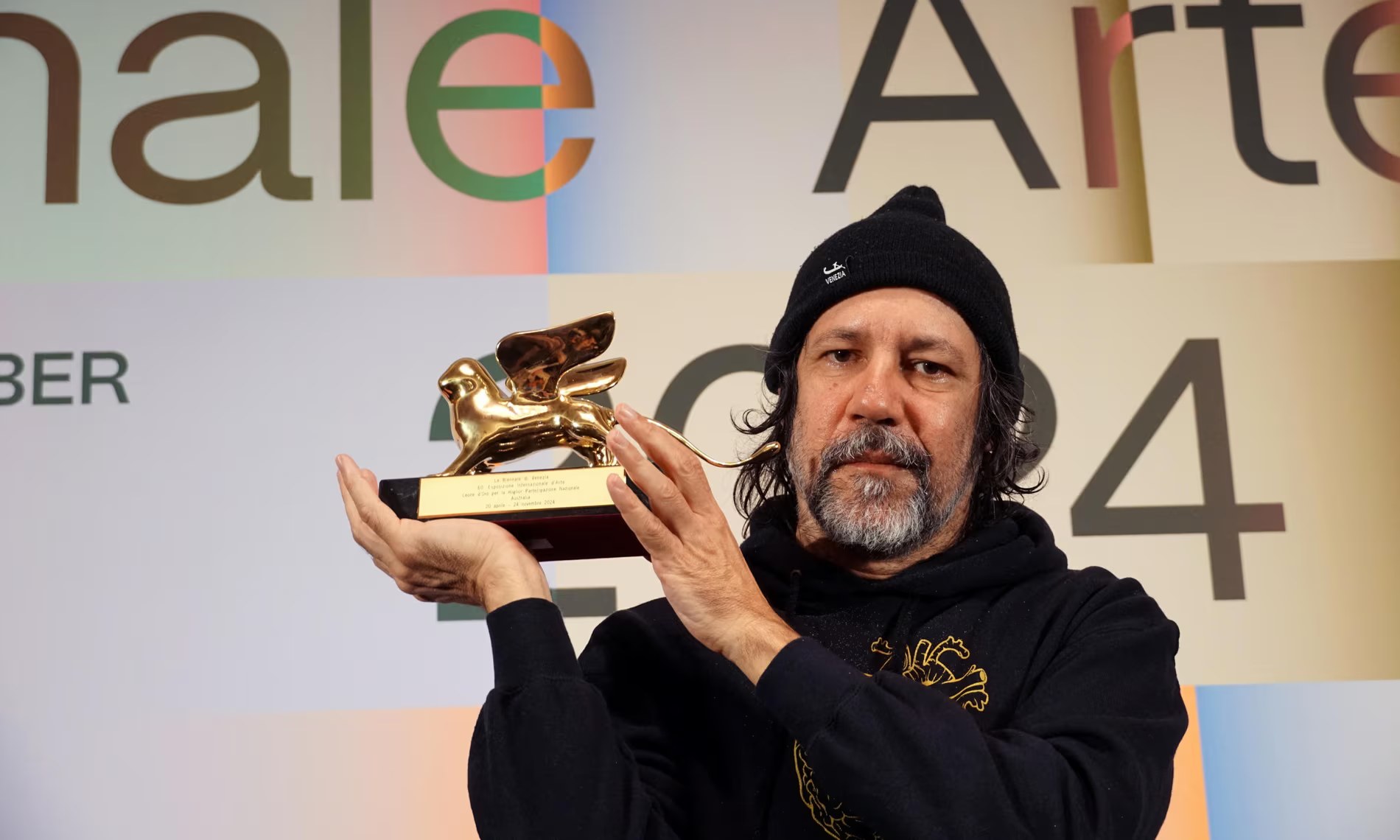Amazing news from La Serenissima. For the first time in the Venice Biennale’s 120 year existence, Australia, which has been there since 1954, has been awarded the Golden Lion for the most impressive Pavilion. It features a work by Kamilaroi and Bigambul man, Archie Moore. And to add to regional joy, Aotearoa/NZ has scored the second Golden Lion for its contribution to the Biennale’s big international exhibition which, itself, recognises Indigeneity in its title, Stranieri Ovunque….Foreigners/Colonialists Everywhere.
Awarding the Australianartist his accolade, the jury of the 60th Venice Biennale said: “In this quiet, impactful pavilion, Archie Moore worked for months to hand-draw in chalk a monumental First Nation family tree. Thus, 65,000 years of history (both recorded and lost, and representing 2,400 generations) are inscribed on the dark walls and ceiling, inviting viewers to fill in the blanks and grasp the inherent fragility of this mournful archive”.
It noted too how official state documents, which were gathered by Moore’s meticulous research and float above a pool of water, “reflect the high rates of incarceration of First Nations people”. They actually represent the 500 deaths in custody that First Nations people have suffered since the Royal Commission called for ways to end this evil in 1991.
The jury said the installation stood out for its “strong aesthetic, its lyricism and its invocation of a shared loss of an occluded past. With his inventory of thousands of names, Moore also offers a glimmer of the possibility of recovery,” it added.
The Venice Biennale jury consisted of an international panel of curators – Julia Bryan-Wilson, Alia Swastika, Chika Okeke-Agulu, Elena Crippa, and María Inés Rodríguez.
Moore said he felt “honoured” to be rewarded for his work. “As the water flows through the canals of Venice to the lagoon, then to the Adriatic Sea, it then travels to the oceans and to the rest of the world – enveloping the continent of Australia – connecting us all here on Earth. Aboriginal kinship systems include all living things from the environment in a larger network of relatedness, the land itself can be a mentor or a parent to a child. We are all one and share a responsibility of care to all living things now and into the future.
“I am very grateful for this accolade; it makes me feel honoured to be rewarded for the hard work one does. I am grateful to everyone who has always been part of my journey – from my kith to my kin (and ‘kith & kin’ was the title of his work), to my Creative Australia team and everyone else back home and those of the Venice lagoon”.
His curator, who helped Moore develop this work from a Queensland Art Gallery exhibition ‘Inert State’ in 2022, was Ellie Buttrose.
Intriguingly, The Guardian’s arts and culture correspondent, Lanre Bakare, reporting from Venice, picked out a prevailing emphasis on “colonialism: both its legacy in the form of restitution debates, and Europe’s lingering presence – physically and psychologically – in those countries that were formerly colonised”. They noted that “More than half a dozen of the pavilions taking part – including Ireland, Portugal, Brazil, the Netherlands, Ethiopia and the UK – contain art or artists who are wrestling with ideas of colonialism and its influence more than half a century after many states gained independence”.
How could they miss Archie Moore???
Meanwhile, over the Tasman, the Mataaho collective comprising four Māori women – Bridget Reweti, Erena Baker, Sarah Hudson, and Terri Te Tau – joined Moore in bringing a Golden Lion Downunder.
The jury noted: “The Maori Mataaho Collective has created a luminous woven structure of straps that poetically crisscross the gallery space. Referring to matrilinear traditions of textiles with its womb-like cradle, the installation is both a cosmology and a shelter. Its impressive scale is a feat of engineering that was only made possibly by the collective strength and creativity of the group. The dazzling pattern of shadows cast on the walls and floor harks back to ancestral techniques and gestures to future uses of such techniques”.
Australia has a meritorious history of Aboriginal art at the Venice Biennale. We heroically shipped a prefab Pavilion to Italy in 1988 and filled it with art by Rover Thomas and Trevor Nicholls at the next iteration in 1990. Just six years later, Emily Kngwarrey, Ngarrindjeri weaver Yvonne Koolmatrie and Brisbane’s Judy Watson shared the space. Ten years later, another Brisbane artist, Tracey Moffatt was the first with Indigenous ancestry to go solo.
Isn’t it about time a great bark artist from Arnhemland – a Mawurndjul or a Ganambarr – is exposed to the world at Venice’s Olympics of art?
Back at the Stranieri Ovunque–Foreigners Everywhere exhibition, curated by the Brazilian Adriano Pedrosa, Buku Larrnggay’s Naminapu Maymuru-White and Ballarat-based Marlene Gilson, with Wathaurung heritage, are both flying the flag for Australia and First Nations, as I reported earlier.




